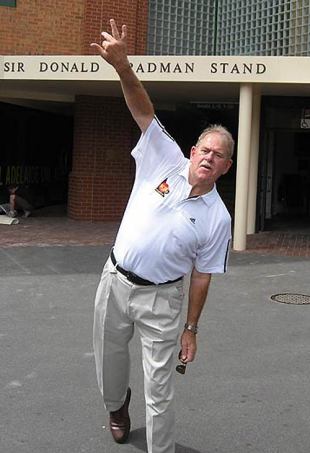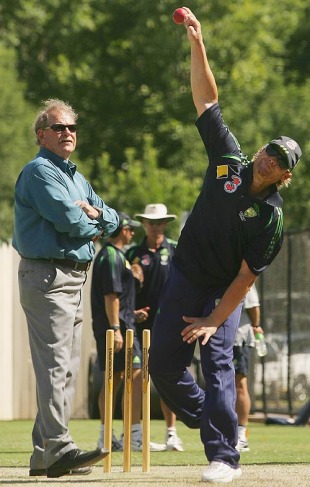|
| 
| "The right pace to bowl at is the pace where you gain your maximum spin" © Siddartha Vaidyanathan |
|
|
During practice and in matches I keep trying different ways of spinning the ball. I get wickets but also go for a lot of runs. How do I stick to the basics for the most part? asked Dylan D from China
It is a mental thing. The most important ball is your stock ball: if you are a legspinner it is the legbreak. You bowl it when you need to keep things tight and when you need to take a wicket. By all means work on your variations, but not before you have got reasonable control over your stock ball.
At times I get the ball to spin a lot but then there are times when it just does not turn. What do I do? asked Chad Williams from Belgium
The ball doesn't always react the way you want it to. In the 2005 Ashes Test
at Lord's, Shane Warne bowled three legbreaks to Ian Bell, who shouldered arms to first two, as they spun a long way towards slip. The third one hit him in front and he was out lbw. He thought it was a variation ball but it was really a legbreak that did not spin.
Why can't all legspinners bowl the googly? Why do some of them lose their main delivery when they start bowling the wrong 'un? asked Milind from the USA
Because of the wrist position. When you bowl a googly, the back of your hand faces the batsman. The more you do that, the less likely it is for your wrist or palm to face the batsman when you bowl the legbreak. It just creates a bad habit. Most legspinners love the thought of bowling the googly which the batsman may or may not pick. But the trouble is the more you bowl it, the more your wrist gets into a position where it won't support your legbreak.
------Also read
--------
I know you do not believe in teaching budding offspinners how to bowl the doosra. But what about the away-going delivery as bowled by Erapalli Prasanna? I believe Harbhajan Singh's, and maybe even Jason Krejza's, doosra deliveries are the sort of floaters Prasanna used to bowl? asks Kunal Sharma from Canada
The thing about the doosra is that the people who have bowled it have normally had their actions questioned. Most of the guys don't have the flexibility to bowl that ball. Graeme Swann has shown how excellent an offspinner can be with an orthodox offbreak and an arm ball - a ball that looks like an offbreak but does not spin. Nathan Hauritz got five wickets against Pakistan
in Sydney bowling the same way. Just because a delivery reacts different off the pitch does not mean the bowler is bowling the doosra. It can often be just a reaction off the pitch.
I would like to know how to make the ball dip. Also, how does a legspinner understand what is the right pace to bowl at? asks Nipun from Bangladesh
The right pace to bowl at is the pace where you gain your maximum spin. Then you vary your pace from there. But you must understand what pace you need to bowl at. That is very important. Warne gained his maximum spin at around 50mph (80 kph). After that, he got less and less spin. For a young bowler that pace could vary between 35-40mph. So whatever speed it is, be satisfied that you can bowl that ball and gain the maximum spin.
Regarding the dip, it comes from over-spin. When you release the ball, you spin it up and generate a lot of over-spin. For the curve, as opposed to the dip, it is important you align yourself with the target which, say is the middle stump. If you just rotate your wrist 180 degrees, release the ball right to left from you hand, there is a good chance the ball will curve in towards the right-hand batsman. Drop is different from curve.
I have watched your 'Masterclass' videos many times but still find it very difficult to bowl the flipper. I understand the concept of squeezing the ball out, but I haven't been able to grasp the idea of doing it in full motion: the arm movement is anti-clockwise and to "squeeze" the ball out of your fingers is clockwise? asked Akash Sureka from the UK
Again, alignment is very important if you are trying to bowl the flipper. You need to align yourself side-on towards your target, which should be around off stump. Then bowl with your shoulder towards that target, flicking the ball underneath as you release it from your hand. Keeping the seam pretty much upright encourages the ball to curve. Your fingers should be above and below the seam because you are using your thumb, your first and second fingers squeezing the ball underneath your hand. But the bowling shoulder needs to be powerful and also bowling towards the target. There is no anti-clockwise. The hand goes straight towards the target.
How do you think Warne got his amazing confidence, leadership skills and competitive spirit? asked Nadir H from India
I believe he was born with that gift just like he was born with the gift of spin. Warne had a massive heart and showed a lot of courage. You didn't know that the first day you met him. The longer he played, the more certain he became of his own ability and then the competitive spirit came forward.
I once heard Warne's technique should not be imitated by youngsters. Is it because there's pressure on his shoulder or that he doesn't have a run-up, so to speak? asked Nihal Gopinathan from India
This is one question I find annoying because a run-up is only for rhythm. Coaches who encourage people to run in like medium-pacers are not allowing the legspinner to go up and over his front leg. It is important that you bowl over a braced front leg. Warne had eight steps in his approach but walked the last three and had lovely rhythm. People said only Warne was strong enough to bowl that way. I don't think so, because as long as you bowl at your natural pace it is fine. If you are looking for a role model why would you not look at the best in the world? Warne had the five basics of spin: he was side-on; to get side-on, your back foot needs to be parallel to the crease and Warne's was; his front arm started weakly but by the time of release it grew very powerful; he drove his shoulders up and over when he released the ball; and completed his action by rotating 180 degrees. Those basics came naturally to him and were the key to him walking up to the crease and jumping to bowl.
Who do you think is currently the best spinner in the world? asked Yazad from India
Going by current performances, Swann is tough to ignore. He is getting important wickets and helping England win Test matches. I think he has every reason to believe, as he does, he should be very highly rated. I like Danish Kaneria, who probably is the best wrist spinner in the world.
Why has Australia not produced a decent spinner since Warne? Do you think Hauritz, Krejza, etc. have not been given the long rope that Warne got in his early days? asked Vijay from Singapore
People forget that Warne was thrown into the deep end and at one stage had 1 for 228 and his career could have been terminated very early. But faith, patience and others' the belief in his ability helped Shane recoup, along with the enormous talent he had. Before him, we had a lot of guys who were average-to-good legspin bowlers. Probably before Warne, Clarie Grimmett was the best legspinner. Richie Benaud was outstanding and consistent but did not spin big. Warne is an once-in-a-lifetime bowler. When he first played, he did not know how to defend himself. As he got better, he learned how to defend himself. That is how you become a great bowler.
Krejza is still in the mix, and at the moment they are pushing for New South Wales' Steven Smith but he is just a baby. Hauritz has shut the door on the others because he has improved steadily in the last 12 months. He has made improvements to his bowling action, is getting spin and drift and is very much a Test-match bowler.
|
| 
| "Warne had eight steps in his approach but walked the last three and had lovely rhythm" © Getty Images |
|
|
Are there any other spin options on the horizon for Australia? asked Allan Pinchen from Australia
One of the difficulties in developing young spinners is the Under-19 competition. Every two years there is an U-19 World Cup. The limited-overs format is not about spin but about containment. When Warne came through the system, they played four-day games. During his formative years he toured England, West Indies and Zimbabwe, bowling in four-day matches. Brad Hogg on the other hand was a ten-over bowler. Between the two World Cups (2003 and 2007) I have no doubt Hogg was the best spinner. But when given the opportunity in the Test side, 10 overs were not good enough. You have to be able to bowl at least 20-25 overs.
Do you think in Twenty20 spinners are at a disadvantage since the ball is always relatively new and hence they don't get enough spin off the pitch? asked Ashish from the USA
Twenty20 is not about spin, even if they say it is. It is really about slow bowling. I watch fast bowlers bowl six slow balls an over. It is about taking the pace off the ball and the same applies to spinners. I watched Harbhajan Singh help India win the 2007 World Cup in South Africa and he was bowling 100kph yorkers wide off the crease. You wonder about the development of the spinner then. I don't think he has been the same bowler since.
With the growing emphasis on the shorter forms of the game, how can any country develop a quality wicket-taking slow bowler? asked John Westover from Australia
That is a great question. In my view we should find ways of getting those young, developing spinners to play longer forms of cricket where they can bowl sustained spells. There are two ways to develop as a spinner: by going to the nets and working on your craft and bowling at targets. Or by experimenting and bowling in matches where you can try the things you tried in the nets. In limited-overs games everyone applauds a dot ball but not the batsman's strokes. To develop as a spinner in the four-day game you have to invite the batsman to play strokes. If the mental approach of all concerned - the coach, captain and team-mates - is to keep it tight, the spinner struggles to develop. We say big bats and short boundaries have created difficulties for a spin bowler but dot-ball cricket has done more damage.



